Newsletter Volume 26 Spring 2020
Head Lines - Peter Olver Symposia
Welcome to New Faculty Retirements
Featured Colleagues Remembering Former Colleagues
Featured Staff Awards and Recognition
Alumnus Spotlight From Our Centers
Charitable Giving Student News
Head Lines - Peter Olver
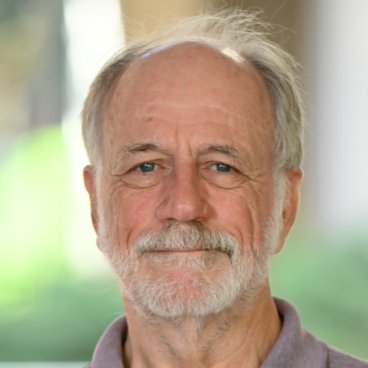
What a year! When I first started thinking about my annual newsletter column back in January, life was more or less normal. Since then, as you are well aware, everything has profoundly changed. The School of Mathematics, like the entire University, has been struggling with operating under COVID-19 restrictions. This has now been followed by protests and riots, triggered by events in our own city of Minneapolis. Like all of you, I am appalled by the murder of George Floyd and the ensuing violent reactions, incited by some in power in this country. Much as many of us mathematicians may prefer to live in our abstract Platonic universe, mathematics impacts society and society impacts mathematics. The golden era of mathematics in the twentieth century cannot be disassociated from the events that led up to World War Two and its aftermath. Similarly, we must be able to face up to the challenges of our society today, and strive to build a mathematical community that is more welcoming to and supportive of all people, encouraging and fostering diversity, equity, and inclusion throughout.
And these were not the only major events to confront the Department this year. In October, the Department hosted an external review, the first since 2005. The expert reviewer team consisted of Irene Fonseca, chair, Carnegie Mellon University (and PhD alumna); Matthew Ando, University of Illinois, Urbana Champaign; James Curry, University of Colorado, Boulder; John Lowengrub, University of California, Irvine (and former faculty member); Judy Walker, University of Nebraska-Lincoln; and Karen Seashore, Department of Organizational Leadership, Policy, and Development, University of Minnesota. The team conducted a thorough in-person review over 2 days, and wrote a detailed and wide-ranging Report. While the Report highlighted our many strengths, significant challenges were mentioned, including: Diversity, Equity, Inclusion (DEI) and departmental culture; budget challenges and substandard facilities; hiring practices; faculty engagement; and graduate student concerns. After a wide-ranging discussion, including a Faculty Retreat in January, a detailed Departmental Response was sent to the review team and the University administration. Among the resulting action items: making a concerted effort, in conjunction with the Diversity Committee, initiated last fall, to address DEI and climate issues; formation of a faculty task force to develop a new hiring procedure; and a comprehensive reassessment and revamping of the graduate and undergraduate programs, including a significant increase in TA stipends.
Despite a University-wide hiring freeze that was imposed in March, we were able to hire two new assistant professors this year: Pei-Ken Hung, who works in differential geometry and relativity, currently at MIT; and Erkao Bao, who works in symplectic topology, from the State University of New York, Stony Brook. Both will join us in fall, 2021. Furthermore, Chuan Xue, who works in math biology and is currently at Ohio State University, will be joining us in Fall, 2020. We are looking forward to the arrival of these three stellar researchers.
After 40 years of dedicated service, Dennis Stanton is retiring at the end of this academic year. Dennis and I both joined the Department in 1980. He has been a mainstay of our world renowned combinatorics group, and has received numerous awards; see, for example, the article about the AMS Special Session in his honor in our 2018 Newsletter.
In sad news, we lost two distinguished retired faculty members this spring. Larry Markus, Regents Professor Emeritus, died on January 30, 2020, at age 97. Let me just add that he and I are mathematical brothers, in that we share the same PhD advisor, Garrett Birkhoff, at Harvard University. On April 17, 2020, Walter Littman sadly died from complications due to COVID-19. Walter was a highly regarded researcher in analysis and control theory. A celebration of both Larry’s and Walter’s long and distinguished careers can be found within the Newsletter.
This is now my twelfth and penultimate year as Head, and our Dean, Mos Kaveh, has announced the search for my replacement. I am looking forward to reassuming my role as an ordinary faculty member, while starting to contemplate retirement. Despite the many challenges that are now confronting us, I am convinced we will emerge from these tests even stronger, just as we have in the past.
Thank you for your continued support of the School of Mathematics. I welcome your feedback, questions, or suggestions — either stop by (after Vincent reopens), call, or send me email.
Stay safe and well!
Peter Olver
olver@umn.edu
612-625-5591
Welcome to New Faculty
Max Engelstein
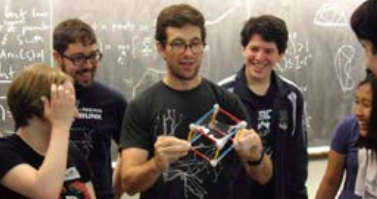
Max Engelstein recently joined the Mathematics Department Faculty as an Assistant Professor. He was born and raised in New York City. He first realized he really loved math when he went to a summer math program for high school students. “It was there I realized that there was a lot of math left to be discovered and that math was less about being quick and clever and more about being curious and exploring.” As a PhD student at the University of Chicago, Max worked with Carlos Kenig on free boundary problems for harmonic measure. “My thesis showed you could apply ideas from the calculus of variations to some of these problems, which was a little surprising given their non-variational structure.”
During his PhD Max also spent three months in Seattle with Tatiana Toro. There he started applying ideas from harmonic analysis and geometric measure theory to free boundary problems.
After completing his PhD Max was an NSF Postdoc/CLE Moore Instructor with David Jerison at MIT, where he worked more on free boundaries and also became interested in geometric analysis. During this period he developed several techniques for understanding the singularities that these problems can develop. Max also attended a semester-long program at the Mathematical Sciences Research Institute (MSRI). “There I continued work at the intersection of Harmonic Analysis and Geometric Measure theory, and was mentored by our very own Svitlana Mayboroda”.
What Max likes most about Mathematics is that “feeling when many seemingly disparate pieces of math come together to form a cohesive picture.” He tries to keep as broad a horizon as possible and look for problems where his tools could be helpful; he also looks for tools in other areas which could help with his problems. He finds that seminars and generally talking to people are good sources of new inspiration in this regard. Outside of math Max likes to read fiction, travel, cook, run and bike. He is also a sports fan (basketball mainly) and is excited about the rich cultural scene in Minneapolis. He and his wife recently adopted a Shih-Tzu mix and says the dog has “the face of a gargoyle but the personality of an angel.”
Paul Carter
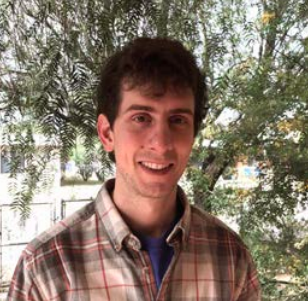
Paul Carter joined the faculty at the School of Mathematics in Fall 2019. He was born in Arlington, Virginia, and grew up in and around the Washington D.C. area until graduating high school. Paul was interested in mathematics from a very young age and enjoyed learning about math throughout his childhood.
During his undergraduate career, Paul studied mathematics at the University of Oxford in the United Kingdom, after which he attended the University of Cambridge for Part III, pursuing studies in differential geometry and theoretical physics. After graduating, Paul attended Brown University to pursue his PhD in mathematics, ultimately focusing on applied partial differential equations and dynamical systems under the supervision of his advisor, Bjorn Sandstede. His thesis work was concerned with the dynamics and stability of traveling wave solutions of the FitzHughNagumo equation, a reaction diffusion partial differential equation describing the propagation of impulses along nerve fibers.
After graduate school, Paul was a postdoc at the University of Arizona, and at Leiden University in the Netherlands. During his postdoctoral work, Paul continued his research in dynamics and PDEs, particularly in systems with timescale separation; these systems appear in a wide variety of applications in which some components operate on shorter or longer timescales than others.
With his postdoctoral mentor, Arjen Doelman, Paul used this theory to understand the formation and dynamics of vegetation patterns in semiarid ecosystems. He plans to continue this research program at the University of Minnesota and aims to use these methods to understand pattern formation in higher spatial dimensions. During his free time, Paul enjoys cinema and is an avid rock climber. His wife, Julia Lerch, is also an academic and is currently an Assistant Professor of Sociology at the University of California, Irvine.
Tsao-Hsien Chen

Tsao-Hsien Chen grew up in new Taipei city, Taiwan. He has a younger brother who is an engineer and currently lives in Taiwan. Both of his parents are teachers in the elementary school that Tsao-Hsien Chen attended. Growing up in a family with parents in the teaching profession, this likely helped to plant the seeds of his interest in mathematics and science very early. When he entered MIT, he was the first generation of his family to pursue a PhD degree. Tsao-Hsien did his undergraduate degree and then pursued a master’s degree at National Taiwan University. He wrote his master thesis under the supervision of Professor Shun-Jen Cheng and graduated in 2006. The project he focused on was canonical basis of the quantum groups. Tsao-Hsien soon decided to go abroad and chose representation theory and algebraic geometry as his field of study. After serving a one-year obligatory military service in Taiwan, he entered his PhD program at MIT in 2007. He worked with his advisor Roman Bezrukavnikov on geometric representation theory. His PhD thesis topic was “Geometric Langlands in Prime Characteristic”. After earning his PhD degree, Tsao-Hsien became a member of the Institute for Advanced Studies (IAS) during the 2012-2013 academic year. He then held the Boas assistant professorship at Northwestern University for three years. Starting in 2016, he was an assistant professor at the University of Chicago. During his time in Chicago, he built valuable collaborations with Ngo Bao Chau, who won the Fields Medal in 2010. In 2019, Tsao-Hsien joined the school of Mathematics at the University of Minnesota. Moving to Minnesota, the land of 10,000 Lakes, Tsao-Hsien says his family are “looking forward to exploring those breathtaking parks and lakes”. In his spare time, he likes watching movies and playing basketball.
Featured Colleagues
Jiaping Wang
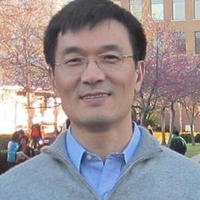
Jiaping Wang joined the Minnesota mathematics faculty in 1999. He was born in 1966 and grew up in the countryside near Ningbo, a seaport immediately south of Shanghai. Now one of the major ports in the world, it was a sleepy backward city back then. His early experiences at school did not particularly predispose him to mathematics. It was the time of the Cultural Revolution, the teachers did not seem well trained and there was a lack of resources. In spite of some partial success in the regional math competition while he was in junior high school, it was not even clear that he should go on to do mathematics until he took the college entrance exam, and was asked to pick a preferred major and college. At that stage his teachers sort of made the decision for him: they picked mathematics and East China Normal University on his behalf. He did not even know the university was located in Shanghai when he was told this decision.
Looking back he realizes that mathematics was probably the best choice for him. At school he slightly preferred chemistry as a subject, but he now takes a dim view of the smells and long hours in labs, and thinks that he would not be as happy doing that.
At East China Normal University Jiaping first completed a B.Sc. degree in 1986, and then an M.Sc. degree 3 years later, a standard progression in China. He regards his Masters thesis advisor, Xintai Yu, as a father figure who influenced him greatly, and who, sadly, passed away in the prime of his life. At that stage he was working on functional analysis and Jiaping’s first four publications are from then and are listed as being joint with Yu.
Jiaping’s PhD advisor, Peter Li, also played a deciding role in his career. It was Li who brought him to UC Irvine in 1990 to complete his 1994 PhD, and who was responsible for a change in research direction to the more mainstream area of geometric analysis. Jiaping is grateful to Li for countless valuable advice and support over the years, and they became long term collaborators over two decades. More recently Jiaping has written multiple papers over the last decade in collaboration with Ovidiu Munteanu, another student of Peter Li. He feels that it is more efficient to work collaboratively, and his publication list is ample evidence of such collaboration.
The most difficult part of research for him is to find interesting and doable problems, and it helps to have different people with different ideas and different strengths. Jiaping also mentions Fields medalist Shing-Tung Yau as providing a great deal of support for his career. This experience with his own mentors shapes Jiaping’s approach to teaching his own students, which he summarizes in three words: expectations, opportunities and encouragement.
During the 30 years Jiaping has been in the US he has visited China multiple times, often giving mathematical talks there, but he says he does not really miss the lifestyle, which is different in some ways. In China the extended family can be very important, and there may be stronger social connections with friends. On the other hand, life in the US seems more peaceful and less complicated.
Outside mathematics, Jiaping likes reading and food, as well as tea and wine. He likes easy hiking in the woods. He goes to museums and is appreciative of art work. He likes to watch opera, both Western and Classical Chinese (predating Peking Opera). The latter is not so easy to see in this part of the world, so he resorts to YouTube!
Svitlana Mayboroda
Svitlana Mayboroda is a McKnight Presidential Professor of Mathematics at the University of Minnesota. She is also the Director of the prestigious Simons Collaboration on the Localization of Waves, headquartered in the University’s College of Science and Engineering. Mayboroda leads an interdisciplinary group of world-renowned scientists in a project that builds on a recent theoretical breakthrough called the ‘localization landscape’. The project goal is a unified understanding of wave localization, enabling the solution of some of the most compelling puzzles in modern condensed matter physics and gaining control over the behavior of waves in disordered media. Among the principal investigators and consultants of the Collaboration are laureates of the most prestigious prizes in science and math: the Abel prize, the Nobel Prize, the Fields Medal, and the Wolf Prize.
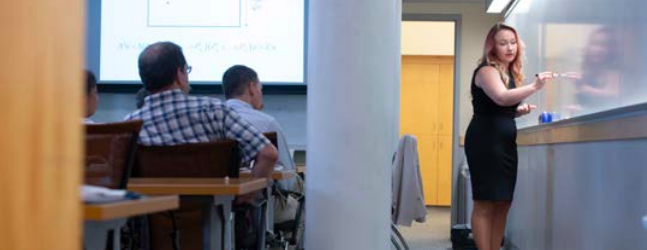
Mayboroda has made major contributions to mathematics and other fields, all outlined on her University of Minnesota homepage. It is astonishing to see the large body of work she has achieved in a relatively short amount of time. She says she did not come to Mathematics as a conscious decision; rather it was the result of an exciting and intriguing opportunity to leave the Ukraine for a PhD in Mathematics at the University of Missouri. “From there the rest is history”.
This theme of exploration and results recurs throughout her career. When asked what propels her forward, she says that she just does what she really wants to do. “It is based on smell and curiosity. When I am exploring a new problem, I just really want to know the answer. That is what drives me”. She is humbled by all the recognition she has received. But “the results are really what have shaped my career. At the outset I never thought some of those breakthroughs would amount to anything”
One of the first examples is the work she did during her Postdoc at the Ohio State University with Vladimir Maz’ya. Together they established the Wiener criterion for higher order equations, which became one of the foundational results in the field. “It was the first time it had ever been done, even for the toy case of the bilaplacian. At that moment Professor Maz’ya thought it was a very big result, but I simply viewed it as another fun adventure”.
Similarly, Svitlana describes the problem she was working on with a collaborator as the origin of what is now the Simons Collaboration on Wave Localization. In 2009 she presented her aforementioned research on the higher order equations, related to the mathematics of thin plate vibration. The presentation caught the attention of Marcel Filoche, CNRS Research Director in the Condensed Matter Physics lab at École Polytechnique in France. He speculated whether the irregular bulging patterns Mayboroda described in thin plates were related to the way acoustic vibrations in his research localized in some places, while disappearing in others, which started a long and fruitful collaboration. It grew to include others including Minnesota applied mathematician Doug Arnold, as well as distinguished harmonic analysts and physicists who took the first steps to apply landscape theory in the context of semiconductors and compared experimental results for cold atoms to the theory.
Svitlana says back in 2009 we had no clue that we would achieve this type of integration. “It brought us to the scope of problems that originally we did not expect.” Now more than ten years later “we have more of a vision; we know what the big problems and issues are. We see the connections, but initially we were just driven by curiosity”. Svitlana now spends more time on papers not involving pure mathematics. She oversees larger projects with more students and postdocs. “While I don’t have the depth in Physics or in Applied Math, I see all the connections; that is still very rewarding”. But she also “craves the mathematics” and still spends a substantial amount of time working on the “pure” side of harmonic analysis and geometric measure theory - she needs to find her corner to work on her theorems and get her “fix”.
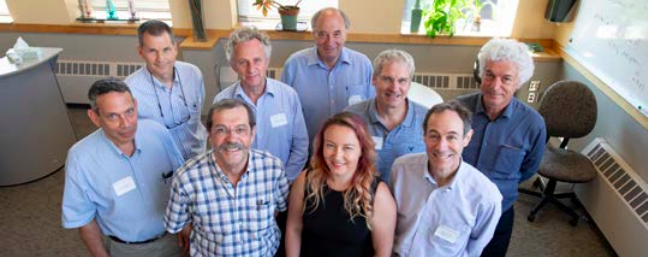
Featured Staff
Bonny Fleming
Bonny Fleming is the Assistant to the Director of Graduate Studies, as well as the Graduate Program Coordinator, and has worked for forty-one years at the University of Minnesota. She started working in Purchasing Services in May, 1973, four days after graduating from High School.
After working for a year she left the University, but returned in 1980 to Purchasing Services, where she remained until 2007. She joined the School of Mathematics in 2007, to assist Scot Adams with the newly created Master of Financial Mathematics (MFM) program. By 2008, in addition to the MFM program, Bonny also began working with the Graduate Studies programs.
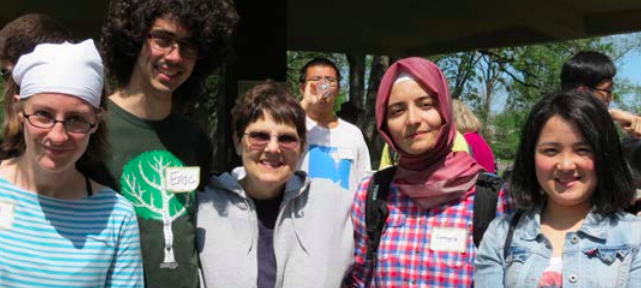
Bonny has fond memories of working in both Purchasing Services and the School of Mathematics, but wishes that she had moved to the School of Mathematics earlier. “Our Department has always treated me more as a person and not a title”. That has been very heartwarming for her and has helped her focus on what she views as her most important job - helping the students, faculty, and staff.
Bonny has played a key administrative support role to many of the School of Mathematics’ leaders as well as countless graduate students. Her knowledge of University systems, creative problem solving, and improvement in administrative processes for a range of Department programs and services has added much value for everyone in the School of Mathematics.
Department Head Peter Olver notes, “She has been an essential member of the School of Mathematics administrative team. We can rely on Bonny to immediately and cheerfully attend to any assigned task, no matter how unusual. She has an amazing rapport with everyone — graduate students, faculty and visitors. Indeed, after her getting settled in, we asked Bonny if she would like to move into her own office, but she insisted on staying at the desk right behind the entrance to Vincent 127 so she could meet and greet everyone who came in.”
Dick McGehee, Director of Graduate Studies, sees Bonny as a “tireless and proactive advocate for our large and multifaceted PhD program. In many ways, Bonny is the graduate program. She has created an irreplaceable sense of family for the students. She keeps candy always on her desk so the students who stop by to chat with her can have a treat. She expresses pride in their work, and she hands out hugs as freely as candy. She makes sure that the students keep up with their paperwork, hounding them mercilessly when they fall behind, but always ending with a kind and supportive word. She also keeps me on task, making sure that all the administrative work gets done on time. More importantly, she keeps track of all the students, making sure that I know what is happening in their lives. I will always remember these years working with Bonny as the best time I have had in administration. I wish that she would stay forever, but she deserves a rest and great happiness in her retirement.”
Scot Adams, founder and former Director of the MFM, remembers Bonny’s impact on the MFM Program. “There were many lucky things at the start of the Financial Mathematics program, but the most significant was that Bonny Fleming became available to help our department at just the right moment. She had an amazing instinct for what needed to happen, and in exactly what order. She brought several new organizational ideas to the table, had excellent rapport with the students and was so adaptable to new technologies. I seriously doubt that the program would have been such an instant success without her”.
Bonny’s boundless support for all the PhD students and their enormous esteem for her are evident. Current PhD student Bryan Felix notes “Were it not for her continuous advice, and relentless efforts in communicating with students, our department would not feel as welcoming as it does.” Somyi Baek, graduating in 2020 notes “Bonny is someone we all turn to when we have any problems or questions that arise in our day-to-day graduate student life.” Somyi says she can’t count the number of times Dick McGehee (her advisor) told her “Go ask Bonny, she’ll know”.
Bonny will be retiring in Fall, 2020. She says she will miss all the graduate students, the faculty (especially Dick), co-workers, and the programs that she supported. She plans to relax and spend winters in Florida in her retirement. Bonny will be greatly missed, but the mark she has left on the Department will have a lasting impact on the organization, its students, staff, educational programs, and infrastructure.
Deb Ronningen
Deb Ronningen has served the mathematics department in the area of finance management since February 28, 2005, managing the bulk of payroll duties along with processing departmental invoices, preparation for Ordway Distinguished Visitors, and the like. She officially started at the University of Minnesota well before this, on January 8, 1990 in Purchasing Services, where she had already been working on a temporary basis. Subsequently she transferred to Printing Services, the Department of Design, Housing and Apparel, and the Department of Orthopedic Surgery before moving to Mathematics.

When she started at the university a computer system known as Walker was used to handle finances. It remained in use until 1991, after which a system with the name CUFS (College and University Financial System) took over. That, in turn, was replaced in 2008 by PeopleSoft Financials, which is what is currently in use. Deb has worked with all of these systems as well as the Electronic Grants Management System for sponsored projects. She comments that the most challenging system has been PeopleSoft!
Deb has enjoyed getting to know the members of each department in which she has worked. There have been many notable experiences, and on occasion she has been on the spot to take crucial action. She recalls a time when a co-worker was having chest pains and she called 911. On another occasion, while walking during lunch break with Bonny Fleming, she came upon a woman who had fallen and was apparently having a seizure. Luckily, a medical student happened to come by on the way to his white coat ceremony. He stopped and called 911, staying until the ambulance showed up.
Deb grew up in Hammond, WI, where she also lives currently, but in between she attended college at UW River Falls, transferring to UW Stout, and then lived in several places on the eastern side of Wisconsin for about 15 years. She has always commuted to the University. She and her husband have two boys and a granddaughter, all living in Wisconsin. Although it has been hard to find free time while working and raising two boys, she loves to read, mostly fiction, with a liking for mysteries, thrillers and historical fiction. She also maintains a small flower garden (which she looks forward to making larger), enjoys counted cross stitch, and knits. Her husband has had a motorcycle since he was 16 years old and they enjoy Sunday rides.
In retirement she plans to enjoy her family and travel with her husband in an RV with the motorcycle in tow, seeing the United States and Canada.
Alumnus Spotlight

Math Senior, Taoheed Bayo, Designs Limited-Edition Sneakers, Nike Afro-Yute, Inspired by his African Roots
(Excerpted from CSE Featured Article)
When Taoheed Bayo applied to the Nike by You x Cultivator shoe design competition, he did so with 50 words and a simple vision— to empower people by encouraging them to connect with where they came from. A senior studying Mathematics at the University of Minnesota, Bayo had never designed a shoe before—or thought about attaching a story to a piece of clothing for that matter. When his submission was selected, he joined 36 other “guest designers” with stories of their own, each of them tasked with crafting a limited-edition Nike sneaker in just one week.
Born and raised in Nigeria, Bayo moved to the United States when he was 15 years old. Inspired by his African heritage, he designed his Air Max 1s using earth tones to represent his home country and leather to symbolize the people. “I chose leather because it [signified] what Africans are—we withstand time,” Bayo said. “So, I connected the endurance of leather to the endurance of us Africans or people of African descent,” he explained.
Bayo called his shoe the Afro-Yute, an amalgamation of “African” and “youth.” Although the shoe is sold out now, fans of the shoe bought 60 pairs over its limited 10-day run. Taoheed Bayo worked with a creative team to produce a short documentary on the inspiration behind his Afro-Yute shoes.
Bayo hopes the Afro-Yute inspires feelings of empowerment and self-realization, but he also wants to show people what they’re capable of. If he can design sneakers, anyone can. “I want to wake up the sleeping giant in everybody,” he said. “This story that I’m telling isn’t just my story, it’s a story of millions of people of African descent out there. “I’m just a voice to tell the story. It’s me telling people that we have so many stories to tell. We have to seek our own truth and find our own heritage.”
While Bayo aims to continue engaging the community through his art and freelance modeling, he doesn’t discount his love for mathematics. Spurred to explore the field by his brother who works in insurance, Bayo is specializing in actuarial science. He believes being equally involved in the arts and the sciences has made him more versatile, not only as a person but also in his future career.
“I’m one of those people in the middle where I can lean to mathematics if I want to but I can also lean to the arts,” Bayo said. “It makes you more of a well-rounded individual, because you can sit and have a conversation with physics and math students and talk about logs, or you can sit with someone and talk about journalism or photography or modeling.”
Above all, Bayo said his key to academic success is maintaining a balance of his artistic passions and his scientific ones. His advice for aspiring artists in CSE? Let your creativity fly. “Math is creative, and science is creative.”
After graduating in May, Bayo had planned to get a summer internship in the actuarial field and then move to New York to pursue fashion and modeling. However, due to the threat of COVID-19, Bayo had to change his plans. “I’m just going to play it by ear and see what the insurance industry or job market looks like later during the year.” Either way, he isn’t planning on forgetting the idea behind his Afro-Yute sneakers anytime soon. “Maybe I won’t design another pair of sneakers, but maybe I can participate in other things to give back to the community and bring people together.”
Story by Olivia Hultgren
Learn more about what inspired the Afro-Yute on Bayo’s Nike by You webpage.
Charitable Giving

Charitable Giving at the School of Mathematics
We thank the many alumni and friends who regularly support our students and faculty in the School of Mathematics. Contributions to scholarships, fellowships, faculty research, and the Mathematics general fund enable the Department to recruit top graduate and undergraduate students, sustain and advance our research, and support our faculty. Community support is critical to our central mission of preparing students to enter graduate study and the workforce having developed the knowledge, critical thinking, and creativity necessary to become tomorrow's leading mathematicians, problem solvers, and innovators. The generosity of alumni and friends like you during this unprecedented time is especially meaningful, as it allows us to continue our important work of educating and supporting our students and faculty through this challenging time. To learn more about giving opportunities and how you can advance the excellence of the School of Mathematics at the University of Minnesota, please contact Emily Strand at ecstrand@umn.edu or 612-625-6798. We wish to extend our deepest thanks to the following donors who made generous gifts in support of the School of Mathematics since our last newsletter (May 16, 2019 - May 15, 2020):
Leadership Donors ($1K +) Allianz Life Insurance Co of North America, Allianz Investment Management, Benevity Community Impact Fund, Gerald E. & Shirley J. Bergumn, Cargill Inc., Cargill Risk Management, Lucinda Cummings & Robert M. Segal, John A. Eagon, ExxonMobil Corp., ExxonMobil Fdn., Federated Insurance Fdn. Inc., Federated Mutual Insurance Co., David Feshbach, Andrea Feshbachm Feshbach Family Char Fund-Vanguard Charitable, Eric J. & Laura Griffin, Kathryn G. Gulliver, Kusum N. Jain, Phyllis L. Kahn, Blaine L. & Lisa A. Mably, David A. Malerich, Dorothy A. & Albert Marden, Willard & Jane C. Miller, Minnesota Life Insurance Co., David C. Oswald, Mark A. Otness & Karin M. Wentz, Chieh Ouyangm, Erik J. & Janelle Rasmussen, Margaret A. & Peter A. Rejto, Rejto Giving FundFidelity Charitable, Svetlana Y. Rudnaya, Mikhail V. Safonov, Dieter S. Schmidt, Pamela G. & Karl E. Streed, William D. & Kathleen M. Tarara, Thrivent Financial for Lutherans Fdn., The Travelers Companies Inc., Voya Fdn., Albert T. & Hai-Li H. Wang, Jing Wang, YourCause LLC
Additional Donors: Jean M. Anderson, James L. & Janet C. Anderson, Thomas E. & Kathleen M. Armstrong, Charleen M. Baker, Peter H. Baxendale, John A. & Jane K. Beekman, Dingjun Bian, Richard J. Braun, Bright Funds, Morton K. Brussel, Elizabeth A. Byrne & Andrew C. Turner, Kalyan K. Chanda, Jeffrey A. & Noelle Chard, Celeste L. & Pratana Chayabutr, Larry W. & Joan L. Christenson, William H. & Marcia L. Cochran, Corporate Giving Program for Best Buy, Angela K. & Richard P. DeLong, Lynn M. Dixon, Hartmut C. Durchschlag, Ronald L. Ellingson, Lance & Jennifer Finney, John N. & Therese Fitch, Thomas A. Freuler, John V. Garnett, Janice O. Gawtry, Google Inc., Leland S. Grotte, Frances F. Gulick, Qiang X. Guo, Irene & Troy M. Holm, Holmlund Thompson Fund- Fidelity Charitable, Leslie H. Hunacek, IBM International Fdn, James & Janet Anderson Acct-Fidelity Char, Warren P. Johnson, Lars Johnson, Margaret A. & Thomas H. Johnson, Gail R. & Donald J. Kleven, Julie R. Lahren & Robert H. Rademacher, Lahren/Rademacher Charitable Fund, Thomas W. & Elizabeth A. Lanzatella, Terry A. LePera, Zhifang Li, Tianyi T. Luo, David E. Mace, Jewell R. & Allan H. Malerich, Anna L. Mazzucato, Stephen A. McGrath, Medtronic Foundation, Jessica Mitra, Mary K. & John W. Moriarty, Rory G. Mulvaney, Gerard P. Naughton, Jane E. Neumann & Karl H. Chun, Amy D. Ngo, Northrop Grumman Fdn, Andrew Odlyzko, Jose A. Orozco Rodriguez & Marie Lopez del Puerto, Philip L. Osterlund, Shelley & Eddie Y. Pak, John G. & Linda J. Phillips, Nicholas S. Pifer, Vincent Quenneville-Belair, John A. & Julia A. Rehnberg, Frederick W. Roos, Richard P. Rozek, Donald J. Ruzin, Paul Sacks, Matthew E. Sanders, Michael A. Savageau, Savageau Family Charitable Fdn, Frederic F. Schnapp, Christine M. Seber & James Morin, Seber Morin Giving Fund-Fidelity Char, Securian Fdn, Deborah A. Shands & Douglas R. Roble, Derek S. Snyder, Vasant A. & Monika G. Sukhatme, Barbara E. & Richard L. Swanson, Synopsys Inc., Target Corporation, David C. Tauzell, Paul Thienprasit, David Thompson & Ingrid Holmlund, Everett I. & Joyce A. Tollerud, Paul M. & Delrene A. Tschida, David M. Tuomala, UnitedHealth Group Inc., Christopher W. Walker, Wells Fargo Fdn, I-Chang Wen, Cynthia J. Whitehead, DuWayne M. & Kay M. Witt, Lisa J. Wright, Jun H. XIa-Cross & Edward M. Cross, William Young, Chen Zhang & Jingxian Li, Robert E. Zink, Felix & Muriel K. Zwiebel
Symposia
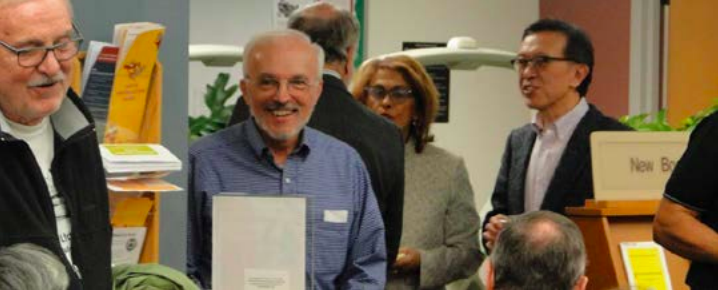
Don Aronson Symposium
Fadil Santosa, Vladmir Sverak and Peter Olver co-organized a meeting in memory of our colleague Emeritus Professor Don Aronson, held at the University of Minnesota on November 1-2, 2019. The meeting was initially designed to commemorate Don’s life and contributions to mathematics, and thereby celebrate 70 years of analysis at the University of Minnesota. After Don’s untimely death, the meeting included a Memorial in the Math Library on the Friday afternoon after the talks ended, with Don’s family, friends and colleagues in attendance. The distinguished speakers at the meeting were, in order of appearance, Luis Caffarelli, University of Texas, Svitlana Mayboroda, University of Minnesota, Fanghua Lin, Courant Institute, John Mallet-Paret, Brown University, Nancy Kopell, Boston University, Sigurd Angenent, University of Wisconsin. Talks were uniformly excellent. The participants and guests greatly benefited from the talks and social interactions, and the opportunity to celebrate Don’s long and distinguished career at the University of Minnesota.
Ordway Visitor
Professor Arnoldo Frigessi (University of Oslo) was a 1-week Ordway visitor at the School of Mathematics from December 1st to December 8th, 2019. He gave talks and did research on computational modeling approaches to oncology and machine learning during his visit. Dr. Frigessi’s research interests are in data science and statistics - including particular focus areas Markov Chain Monte Carlo and Bayesian inference, personalized medicine and mechanistic cancer modeling. He is the director of the Oslo Center for Biostatistics and Epidemiology, and also the director of the Oslo data science institute, BigInsight. He is a member of the Royal Norwegian Academy of Sciences and Letters and Norwegian Academy of Technological Sciences.
2019 Rivière-Fabes Symposium
The 2019 annual Rivière-Fabes Symposium was held from April 12-14, 2019. Distinguished speakers included: Guy David, Jonathan Luk, Eugenia Malinnikova and Juncheng Wei. Some of the main topics discussed this year at the symposium included: Elliptic measure with a lower dimensional boundary, The strong cosmic censorship conjecture in general relativity, Two questions of Landis and their applications, and On Gluing Method I: Type II Blow-up for Fujita Equation in Matano-Merle Regime, On Gluing Method II: Second Order Estimates of Allen-Cahn Equation.
Multiscale Mathematical Modeling of Biological Phenomena Conference
A conference on Multiscale Mathematical Modeling of Biological Phenomena was held on May 20-22, 2019 at the School of Mathematics. The conference centered around topics influenced by the contributions of Hans Othmer, and brought together mathematical biologists from all over the world specializing in multiscale modeling techniques. Biological applications ranged from signal transduction, cell polarization and cell movement to tissue organization, development and cancer. Conference organizers include: Jasmine Foo, Yoichiro Mori, and Duane Nykamp; it was supported in part by the Institute for Mathematics and its Applications (IMA) through its Participating Institution (PI) Program. More detail, including speaker abstracts can be found at https://sites.google.com/umn.edu/mmbio/schedule .
The Mathematics Project at Minnesota (MPM)
The Mathematics Project at Minnesota (MPM) is an annual fourday workshop for undergraduates at the University of Minnesota who come from underrepresented groups in mathematics. Current graduate students organize MPM. Each year right before spring semester starts MPM engages students in academic activities, career building, diversity and inclusion, and community building. Highlights of the program in January of 2020 included excellent individual project presentations given by participants. McCleary Philbin, one of the organizers of MPM 2020 said, “This year was great, because we had our largest and most diverse group of participants yet.” One of the 2020 attendees remarked on the experience, “MPM was a great opportunity for me to make new friends while also becoming more confident in myself and my mathematical abilities.”
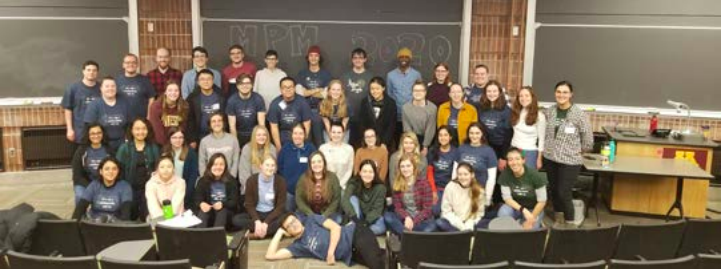
Retirements
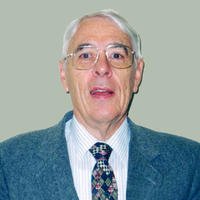
Professor Chester Miracle retired in June 2019 after sixty years of service to the University (having joined the university in 1959). To quote from Professor Olver’s introductory comments to the 2019 Math Newsletter, “Chester (was) the last remaining member of the old College of Liberal Arts Math Department, which was merged into the current CSE Department in the mid 1960’s, and is much valued for his many years of stellar teaching and curriculum development. His longstanding presence in the Department will be missed, but we wish him many more productive years of Emeritus status.” Indeed, Chester received the Outstanding Professor Award from the College of Science and Engineering on more than one occasion, having been a kind and generous yet demanding teacher. As a long-standing member of the curriculum committee he played a major role in the selection of textbooks and his judgment was highly valued. Above all, Chester was demanding of himself and always strove to improve and augment presentations in standard texts, producing numerous sets of lecture notes for practically all the lower division courses.
Chester taught the first course ever on closed circuit television at the University of Minnesota, and for several decades he was the coordinator of correspondence, night school and summer classes. Chester found it especially rewarding to help and advise adult students who were working hard at a day job while completing a math degree. He continued as night school coordinator until about ten years ago when the School of Mathematics programs underwent a consolidation and reorganization. For many years, Chester contributed in a major way as coordinator of the IT/CSE Calculus sequence.
Chester’s skills as a teacher include a remarkable ability to command students’ attention as well as a wry sense of humor. He knew the right moment to lighten up the lecture and is an excellent raconteur. His anecdotes often draw on his remarkable upbringing in the Appalachian Mountains of eastern Kentucky and the almost proverbial hard-scrabble existence that many of us associate with that region. He has, on occasion, enlivened us, by sharing some of his colorful experiences during a mail room conversation, where he would be the center of attention of several colleagues. We wish Chester all the best in retirement.
Remembering Former Colleagues
Don Aronson

We are extremely sad for the passing of Professor Donald G. Aronson on April 17, 2019. Beloved for his collegiality and his sense of humor, Don was deeply respected for his research contributions in partial differential equations and dynamical systems. He was a fount of departmental history, especially about its early years.
Don was born on October 2, 1929, in Jersey City, NJ. He often described Jersey City as a rough and tumble suburb of New York, and delighted in perpetuating the reputation that it was run by thugs. In spite of his humble beginning, or perhaps because of it, he went on to attend the Massachusetts Institute of Technology upon high school graduation. He received all his degrees — BS, MS, and PhD — from MIT, earning the last one in 1956. His wrote his thesis under Norman Levinson, entitled “Boundary Layer Problem for a Linear Parabolic Differential Equation”. In 1954, while still a graduate student, he got a summer job as Scientific Officer at the National Research Development Council in London, England. There he programmed the Alan Turing designed Ferranti Mark I computer, the world’s first supercomputer.
Don’s first job was as a Research Associate with the Digital Computer Lab at the University of Illinois in Urbana Champaign, famous for being the birthplace of an early US supercomputer, the Illiac. In 1956, he moved to the University of Minnesota to join the Department of Mathematics at the then Institute of Technology (now College of Science and Engineering). He was appointed Assistant Professor in 1958, becoming Full Professor in 1965.
Don worked in several areas of partial differential equations and nonlinear dynamics, including nonlinear diffusion, bifurcation theory, pattern formation, and mathematical ecology and biology. Don had over 40 co-authors, consistent with his idea that mathematics research is a “team sport”. He wrote a very influential monograph “The Porous Medium Equation”, published by Springer in 1986. In 1976, he was the principal lecturer in the CBMS Conference at the University of Houston; the topic of his lectures was nonlinear diffusion. In June 2001, a conference, entitled “Nonlinear Phenomena in Science”, was held at the Free University of Amsterdam to honor Don on the occasion of his 70th birthday. In 2013 Don was elected to the Inaugural Class of Fellows of the American Mathematical Society.
Don retired in June 2002. Shortly thereafter, he was recruited by Doug Arnold (IMA Director) and Fadil Santosa (Deputy Director) to join the IMA as their first Director of the IMA Postdoctoral Program, and stayed in this role until 2010.
Don’s place in mathematics is secured. He will be missed for his quick quips, which he dispatched with an endearing twinkle. He will be remembered for his many contributions to the life and the functioning of the mathematics department.
Lawrence Markus
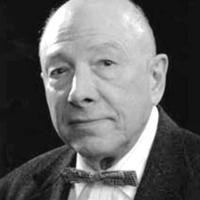
The School of Mathematics was saddened to learn of the passing of Regents Professor Emeritus Lawrence (Larry) Markus on January 18, 2020 at the age of 97. Larry was born in Hibbing, MN on October 13, 1922. Shortly thereafter, his family moved to Minneapolis and then to the Chicago area. Larry attended the University of Chicago, where he obtained his baccalaureate degree in mathematics in 1942 at the age of 19. He then joined the graduate program in the Department of Meteorology at Chicago, where he was as an instructor from 1942- 44 and received his Master’s degree in 1946. During this time Larry served briefly as a research meteorologist for the Manhattan Atomic Project (at the Hanford site) and as chief meteorological officer on a naval weather frigate, the U.S.S. Peoria, in the North Atlantic (1944-46).
After his Master’s degree, Larry moved to Harvard University, where he obtained his PhD in mathematics in 1952 under the direction of Garrett Birkhoff. Larry was an instructor at Harvard from 1951-52. He remained in the Ivy League for five more years, as an instructor and lecturer at Yale and Princeton, respectively, during 1952-55 and 1955-57.
Larry joined the School of Mathematics at the University of Minnesota in September 1957. Beginning as assistant professor, Larry quickly rose through the ranks to become full professor in 1960. In 1980, he was made Regents Professor, a position that he held until his retirement in 1993.
In 1963, Larry co-founded the Center for Control Science in the Institute of Technology here at the University of Minnesota; he served as its director, 1965-73.
The center ultimately morphed into the Center for Control Science and Dynamical Systems, with Larry again at its helm 1980-89. Larry’s reputation in control science led to his being invited to join the mathematics faculty at the University of Warwick, in England, in 1968 as professor in order to set up a similar center of control science there. For the next 25 years, Larry alternated between Warwick and Minneapolis.
Highly regarded internationally, Larry was best known for his work in dynamical systems, control theory, ordinary differential equations, and mathematical models in cosmology. He had a colorful style. This quality was appreciated by undergraduates: in 1968, Larry received the university’s Distinguished Teacher Award. Larry will definitely be missed by his colleagues and former students.
Peyman Ghahremani
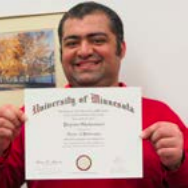
Peyman Ghahremani, a native of Karaj, Iran, and a beloved member of the School of Mathematics, passed away suddenly on January 25, 2020 just months after completing his PhD in Mathematics. Peyman’s background is a testament to both his talent as a mathematician and a unique strength of character. He was an outstanding student in all three of his degrees in Mathematics – at the Khajenasir University of Technology, Tarbiat Moallem University, and the University of Minnesota respectively.
During his graduate studies in the Department, Peyman built his skill as a teacher through his many years as a TA. He also took the time to develop a broad range of coding skills, including: Python, Apache Spark, Machine Learning, Scala, SQL and Tensorflow. He was also very proud of the paper he published: “A short proof of the Bernstein inequality for formal power series”
With strong coding skills and an interest in AI and Machine Learning, he began a career in data science in Silicon Valley, California at Entefy. It is fitting that the firm he worked for focused on addressing challenges to personal and organizational productivity through advanced AI and communication solutions.
Bonny Fleming, Assistant to the Director of Graduate Studies and Graduate Program Coordinator notes: “Peyman was very special to me. He was so alive and full of wonder. I marveled at how excited he was when he came to the School of Mathematics, his enthusiasm when he heard a word he did not know, and how he looked at life. He appreciated everything he had, feared those things he was not sure of, and loved everyone and the State of Minnesota immensely. I miss him so much!”
Peyman’s loved ones remember a man with a big heart and an endearing laugh who carried himself with resolve and who was a role model to friends and colleagues alike. His dear friend Elizabeth Oliver said “Peyman was like a bulldog - biting onto something and not letting go. While he faced many challenges in the last year of his life he always told me a calm ocean does not make a hero captain.” He loved Spanish guitar and playing chess with people around the world. It was Peyman’s wish to remain in Minneapolis, Minnesota, where he spent the last chapter of his life surrounded by friends. Elizabeth organized a fundraising campaign that successfully raised the money to allow for Peyman’s funeral ceremony and burial in Minneapolis. On the site, Peyman’s friend Shahriar Mirzade, said “If we can rally together to help Peyman one last time, we can share in the gratitude of his family who wishes as much as we do for their son to rest in peace. “ Indeed Elizabeth, Shahriar and Peyman’s large circle of friends and family were successful in that effort and laid him to rest in Minneapolis in February of 2020. The entire School of Mathematics misses him dearly. May he rest in peace.
Stan Pride
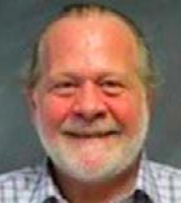
Stan Pride passed away unexpectedly on April 11, 2020. He is survived by his two children, Ginger and Colby Harris as well as his mother, Emily Basinger and her partner Francis, and his two sisters, Cynthia and Laura Pride. He will be greatly missed by the entire Mathematics Department. Just before his passing, as the School of Mathematics Academic Technologist, Stan had taken on a leadership role for the whole department in the ramp up to remote learning during the onset of the Covid-19 pandemic.
He was tireless and completely committed to the effort, spending innumerable hours supporting the Faculty and all Mathematics instructors in this mission critical endeavor.
Stan grew up in Bloomington Minnesota and graduated from Bloomington Jefferson High School in 1985. He attended the University of Minnesota as an undergraduate and was a lifelong learner. He recently completed a course in Educational Psychology and had a keen interest in Machine Learning and Neural Networks. Stan spent most of his professional career developing tools for Plato Learning and brought his years of experience in educational software to the University of Minnesota.
Stan served as the School of Mathematics Academic Technologist from 2018-2020. He was hired to oversee the Minnesota Online Learning System (MOLS) project which houses the Math Placement Exams and is the automated homework system for the PreCalculus sequence. Stan’s passion and talents went far beyond what he was asked to do.
Stan took the lead in the further development of MOLS and worked tirelessly with Wolfram Research to advance the usability for students. Stan also was instrumental in the publishing of a video textbook series in PreCalculus, managing the project and adding animation to the videos to bring the mathematics to life.
Stan was active in the Open Education community and was a leader in the MAA North Central Section Special Interest Group on Open Educational Resources. Stan believed in the philosophy of open education and that there were things that we could do to make education more accessible for all. He worked on projects to incorporate accessibility into the platform and helped to advance the design of the Distributed Open Educational Network (Doenet) project.
Stan was an avid pool player and played regularly in leagues for three decades. His love for the sport and of mathematics can be seen on the cover art for the Trigonometry video text book published by the University of Minnesota libraries.
Walter Littman
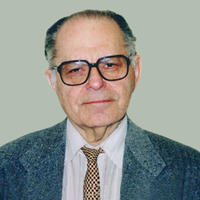
Walter Littman was born on September 17, 1929 in Vienna, Austria. He and his family escaped to Sweden when the Nazis took over Austria, and spent 1940-1941 in Göteborg. In 1941, they took the TransSiber ian railroad across Russia to Vladivostok, and then boarded a ship to Japan, followed by a ship to the United States, where they eventually settled in New York. In 1960, right before coming to Minnesota he married Florence. They then moved into a house in Prospect Park, where they lived for many years, alongside many other Math Department families. Walter and Florence had three children: Philip, Miriam, Benjamin. Ten years after his retirement, Walter sadly succumbed to the COVID-19 pandemic on April 17, 2020.
Walter received his B.A, from New York University in 1952. He completed his Ph.D. at the Courant Institute in NYU four years later, 1956, under the direction of Louis Nirenberg, who also advised our colleague Wei-Ming Ni. His Ph.D. thesis was titled “On the Existence of Gravity Waves near Critical Speed”. He then spent three years as an instructor/lecturer at the University of California, Berkeley, followed by a year as an assistant professor at the University of Wisconsin. Walter joined the University of Minnesota as assistant professor of mathematics in 1960. (In those days, there were two Mathematics Departments, and Walter was in the one in the Institute of Technology, which later became the College of Science and Engineering. The departments were merged in 1965.) He was quickly promoted to associate professor in 1963 and full professor in 1966. He returned to Sweden in 1974-75 as a visiting professor at the Mittag-Leffler Institute and Chalmers Technological University, and was at Hebrew University in Jerusalem during 1981-82. Among his many services to the Department and University, he served for many years as the Master of Ceremonies at departmental meetings and dinners, where he made good use of his endless supply of jokes and quips. Walter retired with the rank of Emeritus Professor in 2010.
Walter was a prolific and highly cited researcher in analysis and partial differential equations, with well over 60 papers published over the years, many coauthored with current and former colleagues, including Avner Friedman, Nestor Rivière, Gene Fabes, Luis Caffarelli, Hans Weinberger, Bob Gulliver, Larry Markus, and Satya Kichenassamy. His paper with Weinberger and Stampacchia on regular boundary points for uniformly elliptic partial differential equations is considered a classic in the field. In later years he wrote a series of influential papers on control theory for partial differential equations, and was a pioneer in introducing direct methods for exact controllability, rather than by duality via observability estimates. He was highly involved in the School of Mathematics’ many initiatives in industrial mathematics, and edited an IMA volume on the topic with Avner Friedman. Walter supervised 8 Ph.D. students at Minnesota, almost all finishing in the 1990’s. A special issue of the journal “Evolution Equations and Control Theory”, dated Dec. 2013, was dedicated to Walter’s retirement. Quoting from the preface to this volume:
“Walter has a remarkable ability to network which arises from a wonderful combination of characteristics; a very friendly, gentle, generous nature, a great interest in people, a great interest in exchanging ideas with people, and an extremely robust memory for people and their work.
Everyone who has visited Walter’s office at the University of Minnesota has a similar story to tell: One is greeted at the door by Walter’s broad, friendly smile. There is only just enough space for Walter and one guest because the office is filled, floor to ceiling with stacks of papers and books. During the conversation, Walter reaches out to these papers and pulls out precisely the ones relevant to the conversation. No need for an electronic version of mathematical reviews or computer archives!”
Awards and Recognition
Promoted Professors

On May 29, 2019, the Board of Regents approved the promotion of Dmitriy Bilyk, Jasmine Foo, and Pasha Pylyavskyy to Full Professor. Professor Bilyk’s research interests are harmonic analysis, discrepancy theory, approximation, and probability. Professor Foo’s research interests are mathematical biology, applied mathematics, and probability. Professor Pylyavskyy’s research interests are algebraic combinatorics.
Promoted Associate Professors

On May 29, 2019, the Board of Regents approved the promotion of Christine Berkesch and Wei-Kuo Chen to Associate Professor with Tenure. Professor Berkesch’s research interests are algebraic geometry and commutative algebra. Professor Chen’s research interests are probability theory and mathematical physics.
Carme Calderer Elected to Royal Academy of Sciences and Arts of Barcelona
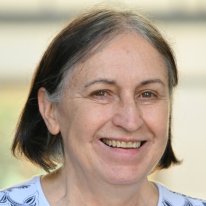
Professor Carme Calderer was elected a Foreign Correspondent Member of the Royal Academy of Sciences and Arts of Barcelona at their general assembly meeting of May 23, 2019. There are 35 Foreign Correspondent Members in all areas, only 6 of which are from the U.S. The Royal Academy of Sciences and Arts of Barcelona was founded in 1764.
Chuan Xue Receives the Pecase Award
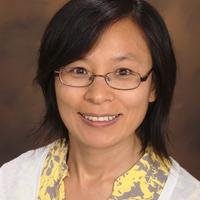
Chuan Xue is a new faculty member, to be joining the Department in fall, 2020. In addition, she is a Mathematics PhD alumnus, having received her degree in 2008 under Hans Othmer. She was awarded the Presidential Early Career Awards for Scientists and Engineers (PECASE), the highest honor bestowed by the U.S. government on outstanding scientists and engineers who are beginning their independent research careers and show exceptional promise for leadership in science and technology. Chuan Xue was nominated by the National Science Foundation (NSF), and honored in an awards ceremony in Washington, D.C. on July 25, 2019. More details at White House press release
MATHCEP Awarded $1.5 Million Grant

Duane Nykamp, Jonathan Rogness, and Mike Weimerskirch were awarded a $1.5 million grant from the NSF Improving Undergraduate STEM Education Program to build an open data-driven educational technology platform and run online learning experiments aimed toward improving open educational content. The grant supports the development of the Distributed Open Education Network (Doenet), a mechanism for measuring and sharing student interactions with web pages and storing anonymized data in an open distributed data warehouse.
Anar Akhmedov Named American Mathematical Society Fellow
On November 10, 2019 Professor Anar Akhmedov was named American Mathematical Society Fellow for 2020 for contributions to core problems in topology.
Women in Math and Stats Team Places 2nd – 2019 Data Science Challenge

The University of Minnesota “Women in Math and Stat” team placed 2nd out of 24 graduate-level teams at the 2019 MinneMUDAC Student Data Science Challenge held at the end of November 2019. The team of graduate students, Somyi Baek, Cora Brown, Sarah Milstein, and Yu Yang, also won the Analytical Acumen Award. MinneAnalytics posed the problem of predicting the price of soybeans in the volatile market of 2019.
Hao Jia and Jeff Calder Receive NSF CAREER Grant Awards
On February 13, 2020, Assistant Professors Hao Jia, and Jeffery Calder were awarded individual CAREER Grants from the National Science Foundation for their projects on “New Mechanisms for Stability, Regularity and Long Time Dynamics of Partial Differential Equations” (Hao Jia) and “Harnessing the Continuum for Big Data: Partial Differential Equations, Calculus of Variations, and Machine Learning (Jeffrey Calder)” The CAREER Award is a prestigious award offered by the NSF to support early career development activities of teacher-scholars that integrate research and education.
Outstanding Teaching Assistant Award
Olivia Cannon, Andrew Hardt, and Michelle Pinharry were the recipients of the 2018 - 2019 Outstanding Teaching Assistant Award. Students submitted 500 nominations for the awards! The Instructional Evaluation Committee chose the recipients based on nominations from students and faculty nominations and evaluations.
Jeff Calder Awarded the Sloan Research Fellowship
Jeff Calder was awarded a fellowship with the Sloan Research Foundation. The Sloan Research Fellowship Program recognizes and rewards outstanding early-career faculty who have the potential to revolutionize their fields of study.
Wei-Ming Ni Receives 2019 Outstanding Ecological Theory Paper Award
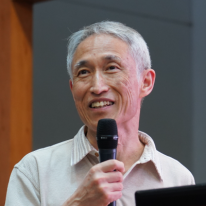
Professor Wei-Ming Ni’s jointly written paper “Carrying capacity in a heterogeneous environment with habitat connectivity” was selected to receive “The 2019 Outstanding Ecological Theory Paper Award” by the ESA (Ecology Society of America). The paper explores “How spatial heterogeneity in environmental factors and movement patterns determine the regional abundance of a population” .
PSLSA – President's Student Leadership and Service Award - Spring 2020

On April 28th, 2020, graduate students María Sánchez-Muñiz and Adrienne Sands received this year’s President’s Student Leadership and Service Award. The award recognizes these students’ outstanding leadership and service to the Department, the University, and beyond. Students are nominated and chosen by a committee based on their leadership strengths, accomplishments, and contributions to the University community.
From Our Centers
School of Mathematics Center for Educational Programs (MathCEP)
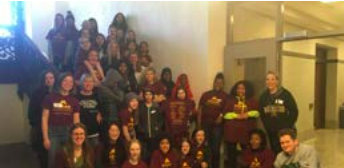
The past year at MathCEP started with welcome news, when the three directors (Duane Nykamp, Jonathan Rogness and Mike Weimerskirch) received a $1.5 million grant from the NSF to build an open data-driven educational technology platform (doenet. org) to facilitate the creation and evaluation of online learning materials.
The University of Minnesota Talented Math Program (UMTYMP) continues to be very strong, and enrollment in our Saturday morning enrichment programs was up 40% this year compared to last. A MathCEP postdoc, Kathryn McCormick, received a continuation grant to continue a special enrichment program aimed specifically at girls in middle school, with the assistance of our other postdocs, Anila Yadavalli and Alexis Johnson.
Unfortunately, the coronavirus had a large effect our programs. The on-campus enrichment events came to a screeching halt in March, and our K12 summer programs have either been canceled or moved online. Meanwhile, our faculty and staff not only worked to convert their own UMTYMP and department courses to the new online format, but served as a resource for other instructors in our department and beyond. Weimerskirch, for example, was a member of a three-person panel in MIT’s Electronic Seminar on Mathematics Education, and gave advice to nearly 200 faculty members from around the country on how best to revamp their courses to an online format.
As always, each year brings transitions with faculty and students. Kathryn McCormick is finishing her postdoc position, and will begin a tenure track position at CSU Long Beach in the fall. The department’s MS Math with Emphasis in Math Education program, whose students worked closely with MathCEP faculty in various programs, will graduate three students this year. Carolynn Johnson and Matthew Brisbin will begin secondary teaching careers (in Minnesota and South America, respectively), and Brinley Stringer will continue on to the joint doctoral program in mathematics education at UCSD/SDSU in San Diego.
Our saddest transition was the sudden loss of Stan Pride this spring (See Remembering Former Colleagues article) Stan was a fantastic resource for faculty in MathCEP and the department as a whole. He was always eager to help and was a friendly, caring colleague. Hours before he died he was part of a virtual “MathCEP Lunch Hour,” taking the time to ask everybody how they were coping with the state’s stay-at-home order, and talking about John Prine and other musicians who had influenced his life. We were all shocked by the news of his passing, and will miss him dearly.
Institute for Math and its Applications (IMA)
As the IMA’s model has shifted away from NSF funding, it continues to develop programs that bring together mathematicians and scientists from academia, industry and government labs. During this past year activities included a highly interdisciplinary program on computational imaging, a summer school on lowdimensional topology, geometry, and applications, a program in graph theory, along with numerous coding sprints and workshops. Along with these programs, the IMA’s Data Science Lab director, Gilad Lerman, organized a popular year-long seminar series in data science and the industrial problems seminar series.
As a visitor institute, the IMA is learning to adapt to the “new normal” brought on by COVID-19. Though many in person programs have been canceled, the IMA will be bringing several programs online this summer, including its seminar series and a version of its Math-to-Industry Boot Camp.
During the 2019-2020 year the IMA continued to strengthen its three year old Data Science Consortium, welcoming in the Mayo Clinic as a full member of the partnership. This consortium, founded three years ago with the inaugural members Target Corporation and Cargill, Inc., provides support for industrial postdocs and scientific activities. Industrial postdocs spend half of their time working on projects directed by industrial scientists and the other half at the IMA doing research with a faculty mentor.
This coming year the IMA looks forward to co-hosting several important activities, including the Math Alliance’s Field of Dreams Conference and the 50th Anniversary Association for Women in Mathematics Research Symposium.
Minnesota Center for Financial & Actuarial Mathematics (MCFAM)

MCFAM students, instructors and Center collaborators were involved in experiential learning, research and public service over the past year. Actuarial and MFM students (Songyu Yang, Yifei Luo, Meggie Wen, and Ameya Phadke) participated in a research project on Indexed Universal Life (IUL) Insurance. Generous funding for the project and collaboration came from Tonkagroup LLC. Songyu Yang presented the research at the largest Actuarial Research Conference in North America (ARC). University of Minnesota sophomores majoring in mathematics, statistics, computer science and economics (Nathaniel Budijono, William Chan, Stuart Fronk, and Kevin Meng-Lin) received an Honorable Mention at the virtual 2020 MUDAC Competition; they analyzed and modeled an industry problem using real world data.
The Machine Learning Summer Camp for High School Students was held over two weeks in June 2019. Camper projects ranged from gender classification, using tweets, to handwritten digit recognition. Sponsors and donors included: Securian Financial, The Travelers Companies, Target, UMN School of Statistics, Nic Pifer, and Hartmut Durchschlag. This summer’s one week virtual Camp is set for July 20-24. More details here on the 2020 virtual camp.
MCFAM was also pleased to accept generous gifts from Cargill Risk Management and Allianz Investment Management. They are the inaugural leadership donors for “The MFM Fellowship for Opportunity and Advancement”, created to fully fund students who increase diversity in the MFM student body. These gifts, as well as others, will be used to recruit the first MFM student to be fully funded for the incoming class of 2021.
Minnesota Center for Industrial Mathematics (MCIM)
MCIM exposes our graduate students to the mathematical challenges and skills that arise in industry, while helping them become either leaders in industry or leaders in academia with a broad background in industrial applications. It also fosters research collaborations between industrial and academic researchers.
In both the fall and the beginning of spring terms, we engaged in a joint IMA/MCIM Industrial Problems Seminar that hosted a wide range of industrial speakers. The seminar talks provided a window on the daily activities of mathematicians in industry. Industrial visitors also got to learn about the strength and expertise within our department. These visits resulted in several summer internships. Additional internships and permanent positions were organized.
The challenges of COVID-19 motivated us to identify ways to increase student access to industrial projects and help to analyze COVID-19 data. MCIM director Gilad Lerman joined a local task force, which includes the Ecolab data science team, where former graduate student, Dr. Jimmy Broomfield works. The task force, graduate student Sarah Milstein and the SIAM Student Chapter, are facilitating, supporting, and working together with students to answer some of the open questions on Kaggle related to COVID-19.
While the IMA/MCIM Industrial Problems Seminar got cancelled this spring, future online summer talks are scheduled with industrial researchers working on COVID-19. Similarly, and in collaboration with the MCIM director, online summer talks are arranged at the IMA Data Science Lab Seminar, featuring leading data scientists who work on COVID-19.
To better prepare for industrial experience in data science, Lerman guided students in data science competitions. Two graduate teams joined the fall 2019 MinneMUDAC student data challenge. The “Women in Math and Stats” team placed second and won the Analytical Acumen Award (See Awards and Recognition article). In the spring, two undergraduate teams competed in the 2020 MUDAC student data challenge, analyzing historical court data and predicting outcomes of civil rights litigation.
Math Library News
The Mathematics Library’s eventful year included not one but two temporary closures. First, a couple weeks over winter break to repair a damaged ceiling, which required asbestos abatement. We took the opportunity to make other improvements, such as installing a large white board by the entrance, which then displayed the AMS’s new Page-A-Day calendar among other things. Students and faculty members coming in and out could thereby get a daily dram of new math.
We also added portable white boards in the reading room to facilitate group study, as well as a large portable monitor that can be connected to any device, but is particularly useful for displaying the Bloomberg Professional financial data, which the library and Minnesota Center for Financial and Actuarial Mathematics (MCFAM) collaboratively provide.
Then there was the COVID-19 closure, beginning in mid-March 2020. Working with the business librarians and the Carlson School MATH LIBRARY NEWS of Management, remote access to Bloomberg was enabled, when usually these database subscriptions are strictly tied to a specific computer. The library also implemented several programs to provide emergency e-book access, most critically to textbooks for large-enrollment courses like calculus (normally not available online for libraries) but also more broadly through the HathiTrust scanned book repository, a Big 10 library collaboration. It’s estimated that the University Libraries are thus providing access to about 70% of the print collection in May 2020; fulfilling requests for the rest will be a priority during the university’s phased reopening. Other information requests are being handled remotely by the math librarian and library assistant (Kristine Fowler and Lynn Tran), working from home; these emails, online chats, and phone calls are close to normal operation. But it was new for Kris to co-teach a session on data management via Zoom and Canvas, rather than in the classroom, for STAT 8801.
We look forward to seeing people back in the Math Library!
Student News
Undergraduate Programs
Graduate teaching assistants Olivia Cannon, Andy Hardt, and Michelle Pinharry received the 2018-19 Outstanding Teaching Assistant Award. The instructional evaluation committee received 500 nominations from students in support of their Math TAs.
Math major Henry Twiss received a 2020 Goldwater Scholarship.
Math majors Ashleigh Adams, Anuraag Bukkuri, and Jacob Ogden were awarded Graduate Research Fellowships in the Mathematical Sciences from the National Science Foundation.
Math majors Angela Chen, Moriah Elkin, Jackson Hampton, Monica Iram, and Deborah Rodriguez received 2020-21 merit scholarships from the College of Science and Engineering.
Thirty-three math majors will be awarded 2020-21 departmental merit scholarships from the Christofferson, Dalaker, Gilquist, Lando, Othmer, Rasmussen, and Thorp funds, totaling $82,000.
One hundred eighty one undergraduates applied for Spring or Summer 2020 graduation with a BA or BS in Mathematics. Faculty advisers selected ten Outstanding Graduates in Mathematics for 2020:
Bernardo Bianco Prado will pursue a PhD in Applied and Interdisciplinary Mathematics at the University of Michigan.
Kenrick Bjelland will work as a software engineer.
Daniel Fuszard will work as an actuarial analyst at Optum.
Beren Gunsolus will pursue a PhD in Mathematics at the University of Minnesota.
Bella Horton will pursue a Masters in Public Health at Columbia University.
Sean McNally will pursue a PhD in Mathematics at Georgia Tech.
Jacob Ogden will pursue a PhD in Mathematics at the University of Washington.
Rebecca Rechkin will pursue a PhD in mathematics at the University of Utah.
Devon Tuma will pursue a PhD in Computer Science at the University of Minnesota.
Julie Yuan will work as a software engineer at Facebook.
Graduate Program
Graduate Student Fellowship Awards
Richard McGehee, Director of Graduate Studies in Mathematics and The Graduate School congratulates the following graduate students who received fellowships.
Avery, Montie, 2019 National Science Foundation (NSF) Fellowship, Arnd Scheel, advisor
Brauner, Sarah, 2019 National Science Foundation (NSF) Fellowship, Victor Reiner, advisor
Jankvic, Salomeam, 2019 School of Mathematics Mark Feshbach Fellowship, Richard McGehee, advisor
Keenan, Liam, 2019 School of Mathematics John Ordway Fellowship, Tyler Lawson, advisor
Ohm, Laurel, 2019 Doctoral Dissertation Fellowship, Robust Energy Landscapes of Non-convex Structured Data Problems, Yoichiro Mori and Daniel Spirn, advisor and co-advisor
Mastrianni, Michelle, 2019 School of Mathematics Fellowship, Victor Reiner, advisor
Sayrafi, Mahrud, 2019 School of Mathematics John Ordway Fellowship, Christine Berkesch, advisor
PhD Graduating Students
Richard McGehee, Director of Graduate Studies in Mathematics and The Graduate School congratulate our recent graduating PhD students (March 2018 to February, 2019).
Bahran, Cihan, Categorifying Induction Formulae via divergent Series, Peter Webb, advisor
Baker, Brittany, How dynamical regime and neuronal network structure influence synchronous events, Duane Nykamp, advisor
Broomfield, James, Invariant Euler-Lagrange-Equations for Variational Problems Defined over Framed Curves in Two and Three Dimensions, Peter Olver, advisor, Data Scientist, EcoLab, Eagan, MN
Collazos, Steven, Coding Properties of Firing Rate Models with Low-Rank Synaptic Weight Matrices, Duane Nykamp, advisor; Assistant Professor, University of Minnesota-Morris, Morris, MN
Diroff, Daniel, On the super Mumford form in the presence of Ramond and Neveu-Schwarz punctures, Alexander Voronov, advisor; Data Scientist, Machine Learning Intern, Akvelon, Inc., Belelvue, WA
Earls, Ashley, Flexoelectricity and three-dimensional solitons in nematic liquid crystals, Carme Calderer, advisor; Visiting Instructor, St. Olaf College, Northfield, MN
Ghahremani, Peyman, The Bernstein Inequality for Formal Power Series, Gennady Lyubeznik, advisor
Handschy, Madeline, Phase transition in random tensors with multiple spikes, Gilad Lerman, advisor; Wei-Kuo Chen, co-advisor, Data Scientist, Applied Math Group, NextEra Analytics, Minneapolis, MN
Hess, Daniel, Highly Structured Multiplication and the Miller Spectral Sequence, Tyler Lawson, advisor; Lecturer 3, University of Chicago, Chicago, IL
Kandola, Shelley, The Topological Complexity of Spaces of Digital Images, Craig Westerland, advisor; Postdoctoral Research Associate, Michigan State University, East Lansing, MI
Logan, Kimberly, Differential equations in automorphic forms and an application to particle physics, Paul Garrett, advisor; Visiting Assistant Professor, Kansas State University, Manhattan, KS
Meyer, Katherine, Metric Properties of Attractors for Vector Fields via Bounded, Nonautonomous Control, Richard McGehee, advisor; Postdoc, Cornell University, Ithaca, NY
Nadeau, Alice, Generalizations for Insolation and Albedo to Adapt an Energy Balance Model to Other Planets, Richard McGehee, advisor; NSF Postdoctoral Fellow, Cornell, University, Ithaca, NY
Negaard-Paper, Shannon, Attractors and Attracting Neighborhoods for Multiflows, McGehee, Richard, advisor; Postdoctoral Researcher, IMA University of Minnesota, Minneapolis, MN and Cargill, Wayzata, MN
Strasser, Benjamin, A Hecke Algebra Approach to p-adic Functionals, Benjamin Brubaker, advisor; Advanced Software Engineer, General Dynamics Mission Systems, Bloomington, MN
Tuttle, Austin, Modeling Regional Variation of Cortical Spreading Depression: A Computational Study, Yoichiro Mori, advisor; Power Systems Developer, Open Systems International, Medina, MN
Walkoe, Iver, Spectral decomposition of pseudo-cuspforms, and meromorphic continuation of Eisenstein series, on Q-rank one arithmetic quotients, Paul Garrett, advisor; Independent Consultant, Self-Employed, Chicago, IL
Weinburd, Jasper, Patterns Selected by Spatial Inhomogeneit, Arnd Scheel, advisor; NSF Postdoctoral Fellow, Harvey Mudd College, Claremont, CA
Yang, Bo, Robin boundary conditions for the Hodge Laplacian and Maxwell’s Equations, Douglas Arnold, advisor, Software Engineer, Microsoft Corp., Redmond, WA